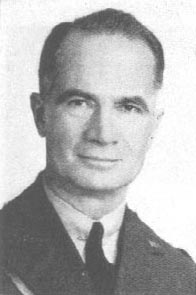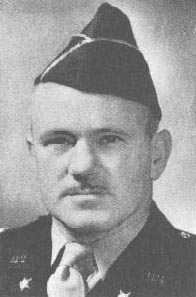INTRODUCTION
The Final Campaign for North Africa
A DELEGATION OF GERMAN OFFICERS arrived at American Headquarters south of
Ferryville at 0926 on the morning of 9 May 1943. Their mission was to surrender
the remnants of a once proud unit of the Wehrmacht, the formidable Fifth Panzer
Army. On the same morning, two German staff officers reported at the Command
Post of the 1st Armored Division southeast of Bizerte to request an armistice.
Three days later, General Jürgen von Arnim was captured at Ste. Marie du
Zit. Marshal Giovanni Messe, commanding the Italian First Army, surrendered
unconditionally to the British Eighth Army on 13 May. The long battle for North
Africa was ended.
These events were the culmination of grand strategy but were made possible
only by the heroic struggle of Allied soldiers across the coastal areas
of North Africa, through deserts, mountains, and swamps. Troops of the
II Corps, U. S. A., who had entered the fight for Africa with the invasion
on 8 November 1942, played a prominent role in the decisive final battle
which opened on 23 April.
The stage had been set for that battle by a campaign, lasting for months,
in which German and Italian troops were finally penned into the northeastern
part of Tunisia. Starting 23 October from El Alamein, General Sir Bernard
L. Montgomery's Eighth Army had pushed the Afrika Korps 1,500 miles along
the desert coast of North Africa and into the Mareth Line in southern Tunisia.
Within 2 weeks of the November landings in Northwest Africa, British and
American forces under General Dwight D. Eisenhower were driving from Algeria
into western Tunisia in an effort to seize the great ports of Tunis and
Bizerte. German reinforcements, rushed into Africa in the nick of time,
stopped the advance just short of the
1
Tunis plain. With operations now made difficult by the rainy winter
season, the Allied Army fought bitter engagements in the mountains from
Sedjenane Station to Medjez el Bab. To the south, American units in hard
fighting stopped savage German drives through Kasserine Pass toward the
Allied base at Tebessa and kept pressure on the long Axis communications
between Field Marshal Rommel and Tunis.
In late March, Rommel's forces were driven from the Mareth Line toward
the north. Protecting his line of retreat, the enemy fought a stubborn
delaying action against the Americans and the British in the El Guettar-Gafsa
area. By 22 April the equivalent of 5 Italian and 9 German divisions were
at bay for what they planned to be a protracted defense of Tunis and Bizerte.
But the Axis was not allowed a breathing space to strengthen its defenses.
The Allied forces, united under General Sir Harold R. Alexander as the
Eighteenth Army Group, were already preparing the blow that was to destroy
the enemy forces in a battle lasting 21 days.
Preparations for the Last Battle
PLANS OF THE EIGHTEENTH ARMY GROUP
(Map No. 1, inside back cover)
General Alexander's Eighteenth Army Group included the British-French
First Army under Lt. Gen. Sir Kenneth A. N. Anderson, the British Eighth
Army under General Sir Bernard L. Montgomery, and the United States II
Corps commanded by Maj. Gen. (now Lt. Gen.) Omar N. Bradley. For administrative
purposes, the II Corps was under the First Army. Supporting the First Army
and
II Corps were the 242d Group (RAF), the XII Air Support Command, and the
Tactical Bomber Force. Thus for the final drive to capture Tunisia, General
Alexander had more than 20 divisions, in 3 main groups, on a front of about
140 miles.
General Montgomery's Eighth Army held the Allied right flank in the
mountainous Enfidaville sector. Its role was to maintain pressure on the
enemy in this area and to advance against his route of escape into the
Cap Bon Peninsula. The main Allied attack was to be delivered in the center
of the front by the forces of the British-
2
French First Army; seven infantry divisions (three French) and nearly
three armored divisions. In this area lay the two principal natural corridors
into the Tunis plain: the valleys of the Medjerda and the Miliane. While
the French XIX Corps, in the Miliane valley, drove northeast, the main
effort was to be along the Medjez el Bab-Tunis axis, in an area where armored
units could best maneuver. The United States II Corps, with the Corps Franc
d'Afrique, was to operate on the left flank of the British attack, with
the high ground southeast of Mateur and the heights between Jefna and Garaet
Achkel as principal objectives. This attack would endanger the flank and
rear of enemy forces facing the British drive.
In its simplest outline, the Allied plan was for a powerful thrust in
the center heavily supported by armor, with secondary attacks on the flanks
to hold the enemy down and prevent him from concentrating to meet the main
effort.
THE ALLIES CONTROL THE AIR
For the months preceding the battle the heavy bombers of the Strategic
Air Force, commanded by Maj. Gen. James H. Doolittle, had been carrying
out raids against Axis shipping, supply lines, and air bases in Tunisia
and in Europe, with significant results for the battle for North Africa.
As the Tunisian campaign developed, the attacks were directed at the transportation
facilities and ports of Sicily and southern Italy, especially Naples, Messina,
and Palermo. Meanwhile medium bombers and fighters were striking at enemy
surface and aerial shipping in the Sicilian Strait. Allied air attacks
and the activities of the British Navy were making precarious any long-term
existence of the Axis forces in Tunisia.
The Tactical Air Force, commanded by Air Marshal Sir Arthur Coningham,
was prepared to collaborate with the field armies in bombing and strafing
rear installations, roads, and convoys. In one sense the final phase of
the Tunisian campaign began not on 23 April but on the nights of 18 and
19 April, when the Allies employed go night bombers against German airdromes
and destroyed 129 Axis planes, including 72 out of 100 enemy transports.
On 22 April the Tactical Air Force destroyed 20 ME-323 6-engine transports
carrying the equivalent of a regiment into Tunisia.
By the opening of the battle on 23 April, the Allied Air Force
3
had won the mastery of the air from the Luftwaffe. One major result,
it is believed, was the enemy's inability to secure knowledge of the surprise
move of the II Corps from southern to northern Tunisia until after it was
completed. During the first 2 days of action, the Tactical Air Force made
1,500 sorties, but from 25 April to 5 May weather conditions grounded most
of the planes. Air power was to play an important role again on 6 and 7
May, when the Allied Air Force blasted the enemy in the Medjerda Valley
and contributed powerfully to the decisive breakthrough by the First Army.
THE II CORPS MOVES TO THE NORTH
When General Anderson, commanding the First Army, issued his operational
orders for the final phase of the Tunisian campaign, the II Corps was completing
an action in southern Tunisia. In order to reach assigned positions for
the attack on 23 April, the II Corps had to move more than 100,000 men,
plus equipment of all types, an average distance of 150 miles over difficult
country and across the communication lines of the First Army. In addition,
supplies for the coming operation had to be assembled from bases and ports
many miles to the west. The accomplishment of this move was one of the
outstanding achievements of transport and supply in the North African campaign.
The 9th Division reached the northern area and began relieving British
units on 12 April. The 1st Division arrived in its zone on 16 April. Forward
units of the 1st Armored Division came into the Beja sector on 22 April,
followed by the 34th Division on the following day.
4

LT. GEN. O. N. BRADLEY
Commanding General, II Corps
United States Army
5

MAJ. GEN. TERRY ALLEN
Commanding General, 1st Division
United States Army

MAJ. GEN. M. S. EDDY
Commanding General, 9th Division
United States Army

MAJ. GEN. C. W. RYDER
Commanding General, 34th Division
United States Army

MAJ. GEN. E. N. HARMON
Commanding General, 1st Armored Division
United States Army
6
Organization of the United States II Corps (23 April-9 May 1943)
(See Annex No. 1, page 54, for Troop List)

7
Summary of II Corps Action
The operation of the II Corps, U. S. A., lasted 17 days and involved
advances Of 25 to 50 miles by four divisions. As ordered by General Alexander,
our main effort was made on the right flank. Three divisions began the
attack on a 13-mile front where advance by the II Corps would best support
the big British thrust in the Medjerda Valley. On the northern part of
our front, one division and the Corps Franc d'Afrique struck at enemy defenses
west of Mateur.
The easiest way to follow the II Corps battle is to see it in terms
of the two main phases in which the action developed in point of time.
In the first phase, 23 April to 3 May, the II Corps stormed or outflanked
all the major German hill fortresses, and forced an enemy retreat to a
line east of Mateur and the Tine Valley on the last hills protecting the
roads to Bizerte and Tunis. In the second phase, 4 to 9 May, the II Corps
struck the new enemy line in key areas, broke through to capture Bizerte
and Chouigui, and forced the surrender of all Axis troops left in its zone.
The II Corps was not fighting isolated battles; its action was always
geared to a coordinated Allied operation. Although the larger story cannot
be told here, the battle of Tunisia was won by the Eighteenth Army Group.
The II Corps played its part, and played it well, in a great Allied victory.
8
page created 10 July 2001
Return to the Table of
Contents
Return to CMH
Online





